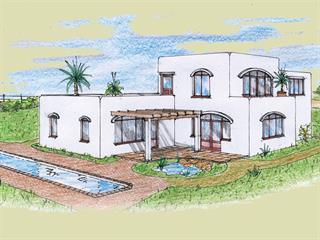Apple and pear farm Vastrap, owned by the DuToit group, is situated just over the Skurweberg in the picturesque Witzenberg Valley, and produces 310ha of fruit annually. While it had endured water restrictions before, these were nothing compared to the drought it suffered in 2004 and 2005. If the situation hadn’t been addressed properly, recalls estate manager Deon van Zyl, many trees would have died. Empty dams, dusty boreholes R ainfall was abnormally low at only 654mm in 2004 and 735mm in 2005, compared to the farm’s long-term average of 1 000mm/year. Dam levels were also much lower than usual. Additionally, the boreholes providing over 70% of the farm’s irrigation water weren’t sufficiently replenished. “Only three of the 12 boreholes still had water in 2004,” Deon recalls. “In 2005 we tried to blow them open with a pressure drill, but all we managed to blow up was dust!” Vastrap immediately went into a state of alert. The use of water for anything but production was stopped and everybody worked together to find ways to save water. Good management One of the first interventions was placing mulch on orchard bunkies. “Mulch helps keep sunlight from the soil’s surface, keeping the soil cool and reducing evaporation,” Deon explains. “It also stimulates root development closer to the soil surface, reducing the need for deep irrigation.
” Around 500 straw bales or 175m³ of woodchips were used per hectare for the mulching. prefers woodchips, as they can be used for five to seven years, while straw needs to be replaced after only two to three. Most of the woodchips are made from fruit trees removed as part of the farm’s replanting programme, but straw has to be transported from Tulbagh, making it almost as expensive as woodchips. In another intervention, long-radius micro-irrigation systems (micros) were systematically replaced with short-radius systems. “Short-radius micros have an 80% water use efficiency, while long-radius micros only have a 45% efficiency,” says Deon. “More water is lost in the area between tree rows with long-radius micros, which supply a 3m area with water. Short-radius micros cover 1,5m.” Today, Vastrap has around 90ha under short-radius micros, and an additional 10ha are replaced each year.
E ach long-radius micro providing 60ℓ/hour of water was replaced with two short-radius micros, with a capacity of 30ℓ/hour each. This helped ensure the hydraulics of the system remained the same. However, Vastrap switched to short irrigation applications of only 30 to 60 minutes, depending on the soil type, instead of six to eight hours per block every two to three days. L ong irrigation schedules every other day are inefficient, explains. “They can easily over-irrigate the soil, wasting huge amounts of water due to run-off, or the long periods between irrigation prepared. Short irrigation cycles were given daily, but, on new orchards established as part of the farm’s replanting programme, it was decided to use drip irrigation with fertigation.
This type of irrigation is even more water-efficient than short-radius micros. Deon believes fertigation will be better for the trees as they’ll receive nutrients daily instead of twice a year. At the moment 65ha are under drip fertigation and the replanting programme is still under way. Precision irrigation The secret to good water management, according to Deon, is measurement. “We created the infrastructure for better water usage by switching irrigation systems to short-radius micros and drip irrigation, then we optimised the system by improving soil moisture measurements,” he explains. Until 2004 soil moisture levels were measured with a neutron meter. Tensiometers were added in 2005. “One neutron measurement per week doesn’t give an accurate picture of what’s happening in the soil,” says Deon. “We modified a few old tensiometers and put two in each soil type found on the farm.” It’s much easier to operate and take readings from tensiometers than neutron meters, and they can measure at shallower depths, such as the 10cm zone where most of the trees’ feeder roots are found.
One tensiometer is placed in a tree’s feeder roots and another beneath them, to measure both the water available to the plant and the unavailable water that has moved past the roots. For optimal water usage, moisture must be managed in the root zone. The goal is to maintain shallow tensiometer readings at 20kPA, and 40kPA at the deeper points. When deviations occur, profiles should be dug up and soil evaluated manually. During 2004 and 2005, situations were rectified depending on the availability of water. Soil moisture management for drip irrigation is similar to that of micros, with two tensiometers used to measure soil moisture content. Soil moisture meters under drip should be read four times a day, compared to only once a day under micros. Drip irrigation only wets the roots, and there’s greater risk of under-irrigation.
Vastrap’s happy ending Vastrap’s interventions paid off. Not only did the farm overcome the drought and still supply the market, it also managed to significantly reduce its water usage. When the water supply normalised in 2006, Vastrap still only used 4 500m3/ha of water, down from 7 000m3/ha to 8 000m3/ha using long-radius micros. Only 1 000m3/ha of water was used on the two-year old trees under drip irrigation. In 2006 a position was created for somebody to continuously monitor the soil moisture, and type data into Vastrap’s computerised water monitoring system. “It’s much better to have somebody investigating the meters and the soil personally,” says Deon. “You know exactly what’s going on in the soil and with the equipment, instead of becoming completely dependent on computers.” Contact Deon Van Zyl on (023) 312 3136. |fw









